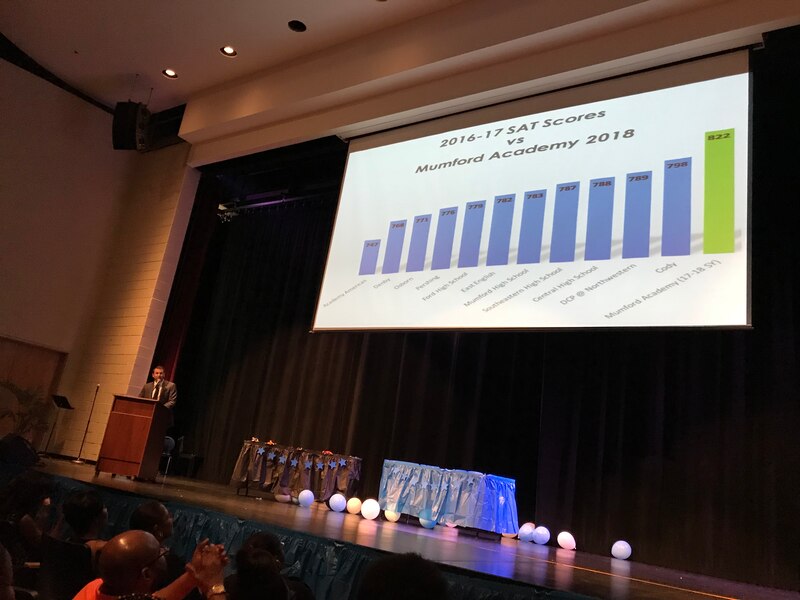The Mumford Academy’s future has been in doubt almost from its first day of existence.
The small school tucked inside the larger Mumford High School started with about 100 ninth graders in 2015, but soon faced a series of threats despite some early wins.
There was news in 2016 that the state-run recovery district that created the small school would be dissolved, and it wasn’t clear what would happen to the academy. There was the possibility in 2017 that Mumford High School, along with the academy inside it, could be shut down by the state after landing on a closure list because of years of poor test scores at the bigger school.
But ultimately, it was the issue of cost that doomed the school in 2018, with officials deciding it doesn’t make sense for a cash-strapped district like Detroit to pay two principals in a building that needs only one.
Despite a promising three-year run, the little school will close this week, leaving teachers and students to wonder if they’ll be able to hold on to the family-like community and strong academic achievements of the past three years when they merge with their larger sister school.
“In the academy, we all became family. That’s why we don’t get in fights,” said Trevor Bradley, 16, a junior at the school. “We all look at each other as brothers.”
The academy was part of an experiment by the state-run Education Achievement Authority to see what would happen if high school students were placed in a smaller environment that didn’t have the baggage of a school like Mumford, which had struggled for years.
“It’s really hard to turn around a low-performing school,” said Jack Elsey, who now runs the Detroit Children’s Fund but was the EAA’s Chief Schools Officer around the time the academy was founded. “Mumford at the time had 600 or 700 students. If you really want to re-orient the culture of a school to be about success … doing that with 700 students is a lot harder than starting with 100, and building a grade at a time over the years.“
Having a smaller school, Elsey said, “creates the kind of environment where you can really get to know every student, get to know their families and better serve them.”
The main Detroit district tried something similar a few years earlier when it broke Cody and Osborn high schools up into smaller campuses. But Elsey, who briefly oversaw Cody and Osborn as an assistant superintendent in the district, acknowledged that the district, under the control of state-appointed emergency managers, didn’t fund or support those efforts enough.
“When you start doing things like cutting funding and requiring the schools to share teachers and requiring them to share operational budgets, you start to chip away at the foundation of what a small school is,” Elsey said. “In a nutshell, anything that is not funded appropriately is going to fail.”
After all three Osborn schools landed on the state’s closure list last year, the district merged them into a single campus. Cody had one of its three schools on that list but the other two were added to a state watch list later.
The Mumford Academy showed signs of success in its first two years. It had the EAA’s highest attendance rate and the state-run district’s highest percentage of students meeting targets on tests that measure how much students learn from one year to the next.
In its third year, after the EAA dissolved and its schools returned to the main Detroit district, principal Nir Saar said SAT scores were encouraging.
Though state officials have not yet released SAT scores for Michigan schools, Saar said during the school’s end-of-year ceremony this month that he’d collected individual scores from his 11th graders — the first at the school to take the SAT. He learned that the school-wide average for the junior class was 822.
If this year’s SAT scores come in similar to those from the 2016-17 school year, an average score of 822 would put the Mumford Academy ahead of most Detroit high schools that don’t use selective admissions, such as Cass Tech and Renaissance.
If you take Cass and Renaissance out of the equation, the average SAT score for high schools that are now in the district was around 805 last year.
“This is how [Mumford Academy students] stack up” Saar told the parents and students assembled in the school auditorium for a celebration on June 8.
He flashed a bar chart on a screen that showed the school’s average SAT score rising above those of 11 other Detroit high schools.

“The message for me is really clear,” he said as he pointed to that slide. “If you have really good ideas and you have the right people to put them in place … you can achieve just about anything and achieve on par with schools that are selecting their students, that are in nicer neighborhoods and have better resources.”
What happens next for the academy’s students and teachers isn’t entirely clear.
Superintendent Nikolai Vitti told the school board before it voted on the mergers of Mumford and Cody last month that students from the different schools would be kept together even after their schools merge.
“They will take classes with each other and stay together, but under one school,” Vitti said.
Mumford High School’s principal, Angela Prince, said in a statement that since she took over the larger school in the 2016-17 school year, she has “been focused on student achievement and turning around what others had counted as a lost cause.”
At the end of the 2016-17 school year, she said, test scores showed Mumford students were moving in the right direction, and the school was named most-improved school in the EAA district.
When the two schools merge, she said, academy students will stay with their same teachers but will have access to more electives than they did when they were at a small school. Entering 9th-graders will be separated into a dedicated 9th grade community that will provide extra support, she said.
“We pride ourselves at Mumford on developing a small family atmosphere and letting students know they are loved,” Prince said. “Our students will continue to excel and be successful, and show that it can happen in a comprehensive high school setting.”
Vitti said he’s not against the small school concept, which has been used extensively in cities like New York.
“There certainly was some positive impact regarding those smaller schools,” he told the board last month. “From a student attendance point of view, from a behavioral point of view and just an overall safety point of view. But one concern that was expressed by individual board members and myself was the large administrative costs linked to having multiple schools, with multiple administrators.”
Merging the schools, he said, would both reduce costs, saving $1.1 million a year at Cody, and between $735,000 and $825,000 a year at Mumford, and “create a clearer vision under one leader.”
Vitti said Saar and two of the Cody principals will be moved to other district schools and will remain principals.
What’s not clear for now is what will become of a leadership training program that had been taking place at the Mumford Academy.
Saar and his top advisors at the academy had been participating in something called the Team Fellows program, a $900,000 effort, funded by the Detroit Children’s Fund, to bring school management coaches from around the country to work closely with the leaders of three Detroit schools.
The idea is to help school leaders — including those who, because of Detroit’s challenges, have never worked in a high-performing school — better understand what has worked in other cities.
Elsey, who now runs the Detroit Children’s Fund, said Saar and his team were selected from among the leaders of 25 district and charters schools who applied to participate. The program started last winter and was supposed to extend through the 2018-19 school year.
Now, Elsey said, he’s not sure what will happen next. One option is to involve the leaders of the larger Mumford, but coaches could move on to a different school instead.
“We put schools through a pretty competitive application process,” Elsey said. “We need to know if that’s the right match.”
Parents and students at the academy say they’re worried about what next year will bring.
“I am upset and really sad about us losing a strong, three-year family because this academy is a strong academy,” said Jerreon Smith, a Mumford Academy junior. “I’m going to miss the environment. It’s most likely going to get lost.”
Jerreon’s mother, Yolanda Johnson, said her son thrived at the small school.
“They get to know you. Your child is not just a number,” she said. “[Students] want to do well when they come into a classroom where they know that the teacher actually knows them, that the teacher will get on the phone and talk to their mother … not just when they’re not doing the right thing, but when they’re doing good.”
Still, Johnson said, she is hoping for the best.
“Hopefully,” she said, “the skills they’ve given them in the academy will be strong enough.”

